Woulda, coulda, shoulda. That was the story of Gram’s life. He’d have turned 70 today, and might have accomplished a whole lot of things had he not checked out (chemically, permanently) in room #8 of the Joshua Tree Inn on September 19, 1973.
I’ve written a lot about the man and his music through the years. Now, just how many more new aspects of Gram can I force feed you?
Let’s take a look at some of his few existing filmed performances, starting with an all-too-short appearance in “The Trip,” a 1967 counter-culture movie directed by Roger Corman. It includes several scenes that feature Gram performing with one of his early groups, The International Submarine Band. It’s hard to catch Gram in action in this clip, because the scenes are short and the editing is fast. But you can see him in the early scene wearing a striped shirt, standing in the middle of the other band members, way in the background. In the party scene he’s wearing a red jacket, high-neck white shirt and sunglasses. He always stands out in a crowd.
Gram wrote the song “Lazy Days” for this film, but Corman felt it wasn’t psychedelic enough for this acid hippie flick. So he kept the scenes of the band lip-syncing and guitar-syncing and replaced the music with a track by the band Electric Flag (listed in credits as The American Music Band). There’s no credit in the film for Gram or the Sub Band. The movie stars Peter Fonda and Bruce Dern and was written by Jack Nicholson.
Gram gets some real face-time at last, flirting and flaunting for the camera in this 1969 video with The Flying Burrito Brothers, the group he co-founded with Chris Hillman in 1968. “Christine’s Tune” is one of the group’s best and most popular songs. He co-wrote it with Hillman (who shares lead vocals) about Christine Hinton, a one-time girlfriend of David Crosby’s. When Christine was killed in a freak car accident shortly after this song was recorded it became known as “Devil in Disguise.” The boys were all decked out in their famous “Nudie Suits” for this performance. But look closely at Gram’s ensemble, embellished with flames, poppies, multi-colored pills, marijuana leaves, crucifixes, and nude women. Of all the outfits designed by Nudie Cohn’s Rodeo Tailors, Gram’s costume is considered the most spectacular of all.
Finally, by 1970, Gram is ready for his close-up, hamming it up as a swinging yachtsman in this video for the Burritos’ “Older Guys.” He had been hanging out with the Rolling Stones quite a bit during this period of his career, forging a drug-fueled, brother-like relationship with Keith Richards. But clearly it was Mick he was shamelessly copying in this video: hands on his skinny hips, scarf around his neck, strutting around with barely a trace of undies beneath his little white pants. Legend has it that some of Gram’s Burrito Brothers hated the way he shimmied and strolled in this performance.
Had Gram lived, would he have wanted to try his hand at acting, as many of contemporaries did at one time or another? Mick Jagger, Roger Daltrey, David Bowie, Tom Waits, and Bob Dylan all took their turns on the big screen. Well, we’ll never know. But one thing’s for sure: his topsy-turvy life and bizarre desert DIY post-mortem would make for one damn compelling “truth is stranger than fiction” film.
Here’s “Lazy Days,” the rejected song Gram wrote for “The Trip.” It later appeared on the Flying Burrito Brothers’ “Burrito Deluxe” LP.
© Dana Spiardi, Nov 5, 2014
Click here to help induct Gram in to the Country Music Hall of Fame.
]]>Buck Owens was a pioneer of the “Bakersfield sound,” an upbeat, stripped-down honky-tonk style of music that mixed old-time country swing with electric guitars and a rocking backbeat. Bakersfield music stood as a type of revolt against the Nashville sound, with its slick, sweet orchestrations and polished production values. Buck enjoyed a 50-year career as a singer, songwriter and musician. He and his band The Buckaroos placed 21 No. 1 hits on the Billboard country music charts. Yet, he never really followed a strict country formula for success.
 Soon after the British Rock Invasion of 1964, Buck started buying Beatles albums and performing “Twist and Shout” using the Beatles’ arrangement of the old Isley Brothers hit. He and his band members even donned Beatle wigs when they performed the song at Carnegie Music Hall for a live album recording in 1966! All the while, The Beatles were requesting four copies of all of Buck’s albums through their mutual record label, Capitol. The Beatles, like many British rockers of that era, loved country music. Their mid-’60s compositions – “I’ll Cry Instead,” “I’ve Just Seen a Face” and “What Goes On” – are among the earliest examples of country-inspired rock songs.
Soon after the British Rock Invasion of 1964, Buck started buying Beatles albums and performing “Twist and Shout” using the Beatles’ arrangement of the old Isley Brothers hit. He and his band members even donned Beatle wigs when they performed the song at Carnegie Music Hall for a live album recording in 1966! All the while, The Beatles were requesting four copies of all of Buck’s albums through their mutual record label, Capitol. The Beatles, like many British rockers of that era, loved country music. Their mid-’60s compositions – “I’ll Cry Instead,” “I’ve Just Seen a Face” and “What Goes On” – are among the earliest examples of country-inspired rock songs.
Eventually, Buck’s penchant for performing pop-rock songs began to elicit criticism from his hard-core country fans. He felt compelled to purchased a full-page ad in the March 1965 issue of the Nashville-based fan magazine Music City News to announce his “Pledge to Country Music:”
I shall sing no song that is not A country song. I shall make no record that is not a country record. I refuse to be known as anything but a country singer. I am proud to be associated with country music. Country music and country music fans made me what I am today. And I shall not forget it.
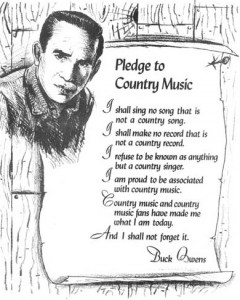 What’s up with that, Buck? Bowing to pressure from purists? When he included Chuck Berry’s “Memphis” on his 1965 LP “I’ve Got a Tiger by the Tail,” he was accused of reneging on his promise. His response: “I see ‘Memphis’ as bein’ rockabilly. I didn’t say I wasn’t gonna do rockabilly. I just said I ain’t gonna sing no song that ain’t a country song. I won’t be known as anything but a country singer. I meant that, I still mean that. Listen to the lyrics. If they’re not country lyrics…the melody…if that ain’t a country melody…The only thing was, a black man was singin’ it, a black man who I was a big fan of.”
What’s up with that, Buck? Bowing to pressure from purists? When he included Chuck Berry’s “Memphis” on his 1965 LP “I’ve Got a Tiger by the Tail,” he was accused of reneging on his promise. His response: “I see ‘Memphis’ as bein’ rockabilly. I didn’t say I wasn’t gonna do rockabilly. I just said I ain’t gonna sing no song that ain’t a country song. I won’t be known as anything but a country singer. I meant that, I still mean that. Listen to the lyrics. If they’re not country lyrics…the melody…if that ain’t a country melody…The only thing was, a black man was singin’ it, a black man who I was a big fan of.”
Well, I’ll overlook him. Those were different times. Besides, he remained a maverick in many respects as the decade advanced. In 1967, he and The Buckaroos suited up in sparkling outfits to play the Fillmore West, a San Francisco hippie venue known for hosting rock bands, not country acts. The band’s dueling Telecaster licks wowed the crowd. Performances like these were a huge influence on a young Gram Parsons, who helped to pioneer country rock during his short life.
That same year, Buck and the boys became one of the first country bands to tour Japan. The resulting album, “Buck Owens and His Buckaroos in Japan,” was perhaps the first country album recorded outside of the United Sates.
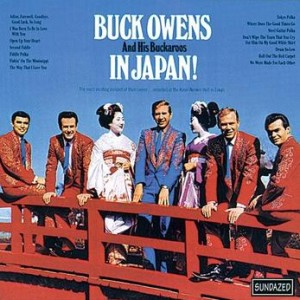
Buck went on to perform at venues not usually frequented by country performers: Madison Square Garden, the London Palladium and the Royal Albert Hall. Interestingly, he never played the Grand Ole Opry in his heyday (save for one brief appearance, when he played guitar for Tommy Collins in 1954). He was a Bakersfield boy, not a Nashville cat. I believe the Rolling Stones were paying homage to Buck in their honky 1978 song “Far Away Eyes,” when Mick sings, I was driving home early Sunday morning, through Bakersfield… The song’s title may even have sprung from these Buck Owens lyrics: I can see that far-away look in your eyes.
Thanks to that ol’ Wurlitzer in my grandparents’ tavern, I knew about Buck even before I heard The Beatles’ version of “Act Naturally.” His 1964 single “I’ve Got a Tiger by the Tail,” with its B side “Crying Time,” was popular among our bar’s coalminer clientele. Those songs were favorites of mine, as well, right alongside all The Beatles tunes. Buck’s records introduced me to country music. As a kid, I loved the western swing of “Tiger,” but it was “Crying Time” that’s long struck my melancholy chord. Mood-spinners like me always know when it’s crying time again.
Happy 86th birthday, Buck, and thanks for always acting naturally.
Here’s Buck and His Buckaroos performing “I’ve Got a Tiger by the Tail” in 1966. Oh, the gorgeous, glittering suits! I think it’s pretty durn cute the way Buck grins while he’s singing this song.
Oh, “Crying Time”! What fabulous lyrics. White man’s blues. Even though Buck wrote this song and recorded it in 1964, it was Ray Charles’ 1966 version that became the bigger hit.
© Dana Spiardi, August 12, 2015
]]>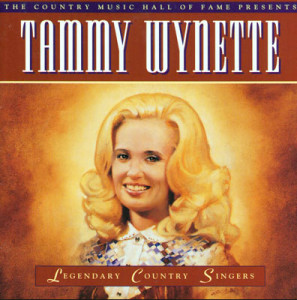 Okay, rock fans of the ’60s and ’70s, it’s time to get brutally honest and swallow your hipster pride. Can you please admit you’ve heard of country singer Tammy Wynette? And, if you know the name, are you self-assured enough to admit you’ve heard, or even enjoyed, her 1968 chart-topping single, “D.I.V.O.R.C.E.”? C’mon, fess up! The chanteuse we kids referred to as Tammy Why-Not sings the syrupy story of a couple on the verge of splitsville, who spell out the D word so little J.O.E. won’t understand. Look, I’m not suggesting you listened to what we used to call “country-western” stations during your formative Zeppelin-rich teenage years. I’m just saying that maybe you heard the song during a visit to Aunt Hazel’s house for Sunday dinner. Or perhaps you heard it blaring from the window of a passing Ford pickup. Or maybe, like me, you heard a snippet of it in a “K-Tel All-Time Greatest Country Hits Collection” ad that aired during commercial breaks for the Mike Douglas Show.
Okay, rock fans of the ’60s and ’70s, it’s time to get brutally honest and swallow your hipster pride. Can you please admit you’ve heard of country singer Tammy Wynette? And, if you know the name, are you self-assured enough to admit you’ve heard, or even enjoyed, her 1968 chart-topping single, “D.I.V.O.R.C.E.”? C’mon, fess up! The chanteuse we kids referred to as Tammy Why-Not sings the syrupy story of a couple on the verge of splitsville, who spell out the D word so little J.O.E. won’t understand. Look, I’m not suggesting you listened to what we used to call “country-western” stations during your formative Zeppelin-rich teenage years. I’m just saying that maybe you heard the song during a visit to Aunt Hazel’s house for Sunday dinner. Or perhaps you heard it blaring from the window of a passing Ford pickup. Or maybe, like me, you heard a snippet of it in a “K-Tel All-Time Greatest Country Hits Collection” ad that aired during commercial breaks for the Mike Douglas Show.
Hmmm, never heard the song, eh? Well, in order to appreciate the parody I’m about to present, you must first give this a look. Now, keep in mind that even though Tammy didn’t pen this ditty, she sure knew a thing or two about divorce, having tied the knot five times before her death at age 55.
That song was just begging to be spoofed!! And the first to do it was a wild and woolly guy with a funny accent who lived far across the pond in Scotland. His name is Billy Connelly — a former shipyard boilermaker, who’s well-known in Great Britain as a folk singer, musician, comedian, and actor. He made a big splash in November 1975, when his parody of Tammy’s tear-jerker reached number one in the U.K. It’s one of the few “spoof” songs to achieve that level of success. Personally, I think his little tale is every bit as S.A.P.P.Y. as Tammy’s!
© Dana Spiardi, Nov 22, 2013
]]>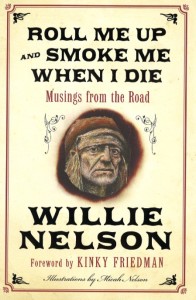 “We create our own unhappiness. The purpose of suffering is to help us understand we are the ones who cause it.”
“We create our own unhappiness. The purpose of suffering is to help us understand we are the ones who cause it.”
“Most of the stuff I’ve read about me has been true.”
“It’s a good thing I had a bag of marijuana instead of a bag of spinach. I’d be dead by now.”
“You know why divorces are so expensive? They’re worth it.”
“But if you think of all the people who don’t like me, just think of all the millions who’ve never heard of me!”
“I like myself better when I’m writing regularly.” [Yer blogger’s comment: Me, too.]
His memoir is available in America’s few remaining bookstores, and on Amazon.com.
© Dana Spiardi, Nov 25, 2012
]]>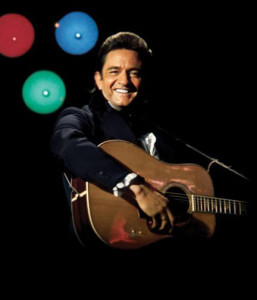 The Smothers Brothers – Dick and Tom – are hailed as freedom-of-speech heroes for their battles with CBS network executives who censored, and eventually cancelled, their trippy 1967-69 “Comedy Hour.” But few followers of music and TV history are aware that Johnny Cash also stood up to the company men who attempted to police his 1969-71 TV variety show.
The Smothers Brothers – Dick and Tom – are hailed as freedom-of-speech heroes for their battles with CBS network executives who censored, and eventually cancelled, their trippy 1967-69 “Comedy Hour.” But few followers of music and TV history are aware that Johnny Cash also stood up to the company men who attempted to police his 1969-71 TV variety show.
In March of 1970 Johnny fought to bring then-controversial folk singer Pete Seeger to his show, despite the network’s fears that Seeger would perform songs critical of the Vietnam War and President Richard Nixon’s administration. Just a few years earlier, Seeger’s song “Waist Deep in the Big Muddy” was cut from a Smothers Brothers show when he refused to remove a verse from the anti-war anthem. Seeger refrained from singing protest songs on the Johnny Cash Show, but the mere appearance of this peacenik pariah on network TV was considered a small victory for Cash in an age of hardline government clampdown on anti-war protestors (the Kent State killings were just months away). Here’s Pete:
In 1971 the Man in Black invited singer songwriter Kris Kristofferson to perform on his show. The two sang “Sunday Morning Coming Down,” with the lyric, “on the Sunday morning sidewalk; wishing, Lord, that I was stoned.” TV execs insisted they change the lyric to “wishing, Lord, that I was home.” But Johnny stood firm, and Kris’s original words remained. Keep in mind, youngsters, that this so-called hedonistic era was, nonetheless, ruled by all-powerful conservative star-makers like Ed Sullivan, who forced The Rolling Stones and The Doors to alter their drug- and sex-oriented lyrics for live TV appearances (The Stones complied, The Doors did not). Here’s the original clip of “Sunday Morning Coming Down” from that show:
The 58 episodes of the Johnny Cash Show were recorded at Nashville’s Ryman Auditorium, which was then the home of the Grand Ole Opry. The variety series featured legendary artists such as Bob Dylan (who appeared on the first show), Joni Mitchell, Linda Ronstadt, Neil Young, Derek and the Dominos (featuring Eric Clapton and Duane Allman), Gordon Lightfoot, Cass Elliot, Neil Diamond, Creedence Clearwater Revival, Dusty Springfield, Arlo Guthie, Merle Haggard, James Taylor, and Louis Armstrong (in one of his last TV appearances).
In the late 1960s, few prime time television shows featured openly Christian headliners, but Johnny stuck to his values and the show succeeded despite “network anxieties.” Unfortunately, ABC canned the program in 1971 as part of a network-wide “rural purge” that resulted in the cancellation of popular rural-themed shows with older-skewing audiences: The Beverly Hillbillies, Green Acres, Lassie, and The Glen Campbell Goodtime Hour, to name a few. But Johnny and his guests had fun while it lasted. Here’s a clip of him clowning with The Monkees (sans Peter Tork), in a show from 1969.
And, if that’s not weird enough for you, here’s a clip of Dennis Hopper reciting Rudyard Kipling’s classic poem “If” on Johnny’s show in 1970. If you can keep your head when all about you… (are getting stoned and blaming it on you!)
© Dana Spiardi, June 13, 2012
]]>